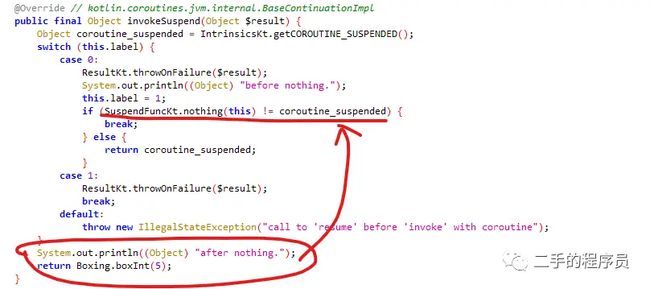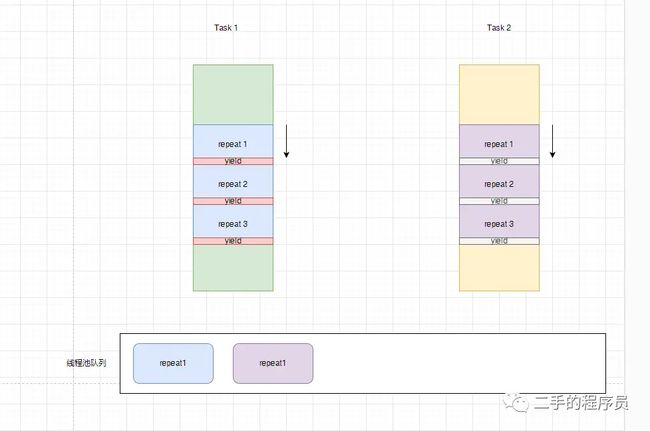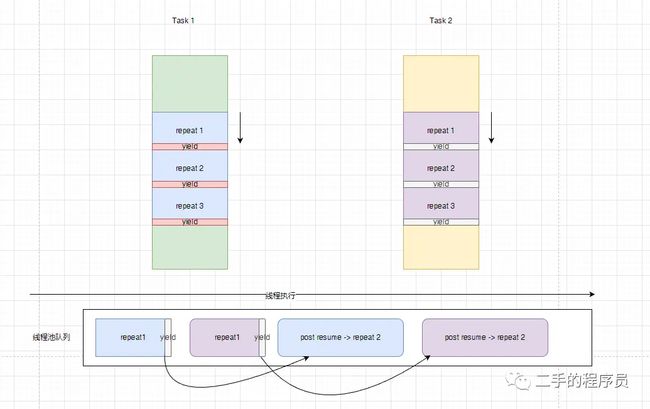速通协程,一步到位!
前言
协程的概念最核心的点就是一段程序能够被挂起,稍后在挂起的位置恢复,挂起和恢复是由使用者控制的。
数学模型
在一个线程的视角中,我们的程序是按照顺序来执行的,假设我们使用??????来描述一段程序的所有指令。那么协程就是该指令流中的一部分(我们让该协程也运行在当前线程上),我们假设它为????,此时 0 < i < j < n。协程中会存在挂起函数,假设挂起函数对应的指令为??,此时 i < k < j。
协程神奇的地方就在于,当指令从???执行到???的时候,它是顺序的,和正常没有区别。当指令从???执行到???的时候,也是和正常没有区别。当指令遇到???的时候,该程序就不往下执行了,而是跑去执行???了,这就是我们上面所描述的该协程挂起了,那么什么时候恢复呢?等挂起函数的工作做完了,协程就会恢复了,然后通过一些方式来告知当前线程,该执行??到???的指令了。
上图中展示的是协程在当前线程的情况。因为我们不知道挂起函数要耗时多久,所以,将3号线化成了虚线。而且,我们应该注意到一个有趣的现象,就是挂起函数将协程代码分成了两块,原本我们在代码里面写的是一个连续的逻辑,但是从协程的角度来看,它们并不连续,理解这一点非常重要。
协程的基础
上面我们画了协程的流程,协程就是一个程序的代码块,为了简单起见,下面我们称呼协程为 Program code block,简称 PCB,非常的 nice。我们做Android开发的,通常使用的是 kotlinx 封装了好多层之后的函数,里面隐藏了太多的东西,由于过于透明,反而导致难以理解,所以我们从最基础最重要的几个协程方法说起。协程的创建创建协程使用 createCoroutine 方法:
val s = suspend {
1
}
val c = s.createCoroutine(object : Continuation {
override fun resumeWith(result: Result) {
println("Coroutine End: $result")
}
override val context = EmptyCoroutineContext
})
c.resume(Unit)
我们先来看看 createCoroutine 的声明:
@SinceKotlin("1.3")
@Suppress("UNCHECKED_CAST")
public fun (suspend () -> T).createCoroutine(
completion: Continuation
): Continuation
其中 suspend()->T 是 createCoroutine 函数的宿主,也就是使用了扩展函数,需要一点 kotlin 的语法知识。我们能在一个 suspend {}?这样一个东西上调用该方法就是因为这种写法了。上面的程序中,s 变量就是一个协程,可以看看源码:
@kotlin.internal.InlineOnly
@SinceKotlin("1.2")
@Suppress("INVISIBLE_MEMBER", "INVISIBLE_REFERENCE")
public inline fun suspend(noinline block: suspend () -> R): suspend () -> R = block
可以看到它就是一个代码块,我们说一个协程是一个 PCB 也不是瞎说的。协程里面会涉及到很多高阶函数的东西,这个与协程本身无关,但是会影响理解协程。继续分析协程的创建代码,我们看到有一个参数completion,它在协程执行完成后调用,实际上就是协程的完成回调。createCoroutine 返回一个 Continuation,我们像启动协程,就需要使用这个类了。
协程的启动
调用 continuation.resume(Unit) 之后,协程体会立即开始执行。这是为啥呢?其实是由于,我们的编译器在处理协程代码块的时候,生成了一个类:
里面带$符号的类,就是编译器自动生成的。当我们调用 Continuation 的方法时,它是一个 SafeContinuation 的实例,但是它只是一个包装类,真正执行逻辑的是里面的 delegate 变量,而这个 delegate 变量就是编译器生成的类的实例了。至于它是如何传递进去的,有兴趣的可以自行研究,不深入了。
反正就是 resume 方法经过一些方法调用,最后会调用到 invokeSuspend 方法里面,该方法就是储存的协程代码块的逻辑。而且最妙的地方在于,我们的 PCB,也就是 suspenc {}?被编译器改写成了 switch case 的方式。为啥要这样呢?前面说过了,挂起函数会将 PCB 分成好几个块,所以每一个块的逻辑会对应一个 case,如此这般,这般如此,协程运行时的流程就出来了。
来个例子
fun main() {
testCreate()
}
fun testCreate() {
val continuation = suspend {
println("In Coroutine.")
5
}.createCoroutine(object : Continuation {
override fun resumeWith(result: Result) {
println("Coroutine End: $result")
}
override val context = EmptyCoroutineContext
})
continuation.resume(Unit)
println("end")
}
该程序的输出如下:
In Coroutine.
Coroutine End: Success(5)
end
套一下我们上面画的图,协程里面没有挂起函数,所以协程是一个整体(该 PCB 只对应 switch 里面的一个 case),所以输出很明显和正常程序没啥区别。再看第二个例子
fun main() {
testCreate()
}
fun testCreate() {
val continuation = suspend {
println("In Coroutine.")
// 这里不同
delay(3000)
5
}.createCoroutine(object : Continuation {
override fun resumeWith(result: Result) {
println("Coroutine End: $result")
}
override val context = EmptyCoroutineContext
})
continuation.resume(Unit)
println("end")
}
与第一个例子不同的地方在于,我们在协程里面写了一个挂起函数 delay,delay 会切到别的线程去执行,我们后面再具体讨论。
可以想一下,现在程序的输出是什么,按照上面的模型来看,应该是:
In Coroutine.
end
Coroutine End: Success(5)
虽然思路是没错,但是由于我们是简单测试,所以 println(“end”)?执行完之后,程序就结束了,实际上是看不到 Coroutine End: Success(5)?打印出来的,实际输出如下:
In Coroutine.
end
协程的启动2
一般来讲,我们创建协程后就会立即让它开始执行,因此标准库提供了一个一步到位的API——startCoroutine。它与createCoroutine除了返回值类型不同之外,剩下的完全一致:
@SinceKotlin("1.3")
@Suppress("UNCHECKED_CAST")
public fun (suspend () -> T).startCoroutine(
completion: Continuation
)
挂起函数
上面我们说到,一个挂起函数会将 PCB 挂起(切成2块),而使用 suspend 关键字我们就能创建一个挂起函数:
suspend fun nothing() {}
那么,我们使用这个函数能挂起协程吗?看代码:
fun main() {
testSuspendFunc()
}
suspend fun nothing() {}
fun testSuspendFunc() {
val continuation = suspend {
println("before nothing.")
nothing()
println("after nothing.")
5
}.createCoroutine(object : Continuation {
override fun resumeWith(result: Result) {
println("Coroutine End: $result")
}
override val context = EmptyCoroutineContext
})
continuation.resume(Unit)
println("end")
}
按照,我们的模型,该输出应该是:
before nothing.
end
after nothing.
Coroutine End: Success(5)
但是不是,实际输出是:
before nothing.
after nothing.
Coroutine End: Success(5)
end
为何会如此呢?很简单,应为编译器知道你只是写了一个假的挂起函数,所以并没有真正的将 PCB 分成两块。
我们看一下编译后的代码就明白了:
可以看到,编译器确实是将 PCB 进行切块了,但是它很鸡贼,它判断了挂起函数的返回值,如果这个函数的返回值不是挂起状态,说明是个冒牌货,那么就 break,然后执行后部分的代码。**我们应该注意到,这个挂起函数的返回值非常的重要。**所以,可以思考一下,我们在协程里面的任意地方添加 Thread.sleep()?函数会影响输出结果吗?假设我们能将 nothing()?的返回值改成COROUTINE_SUSPENDED又会怎样?
挂起协程
协程库里面有很多内置的挂起函数,那么它们是如何做到挂起协程的呢?
有一个基础函数可以做到,suspendCoroutine,它可以获取到它所运行在的协程对象。
@SinceKotlin("1.3")
@InlineOnly
public suspend inline fun suspendCoroutine(crossinline block: (Continuation) -> Unit): T {
contract { callsInPlace(block, InvocationKind.EXACTLY_ONCE) }
return suspendCoroutineUninterceptedOrReturn { c: Continuation ->
val safe = SafeContinuation(c.intercepted())
block(safe)
safe.getOrThrow()
}
}
可以看到这个函数的返回值是 safe.getOrThrow()?。
当我们启动一个协程的时候,改协程的结果状态为 UNDECIDED,然后我们在协程里面调用 suspendCoroutine,该函数会返回 COROUTINE_SUSPENDED ,导致协程逻辑上真正的被切片。
我们实践一下,看一个例子:
suspend fun suspendFunc02() = suspendCoroutine { _ -> }
fun main() {
suspend {
println("a")
suspendFunc02()
println("b")
}.startCoroutine(object : Continuation {
override val context = EmptyCoroutineContext
override fun resumeWith(result: Result) {
result.getOrThrow()
}
})
println("c")
}
这个程序的输出是:
a
c
为何后面没有输出b呢?是因为协程一直被挂起,没有人恢复它。所以我们想写一个自己的挂起函数,还需要考虑如何恢复协程。那么如何恢复呢?suspendCoroutine 提供了一个参数,它可以操作我们的协程对象:
suspend fun suspendFunc02() = suspendCoroutine { c ->
c.resume(996)
}
问题在于,这样直接写行吗?我们上面贴过 suspendCoroutine 的逻辑,它会先执行 block,也就是我们写的 c.resume(996) 这行代码,然后再 ?getOrThrow 获取返回值。巧就巧在,resume 方法会改变 result 的值为 996,从而导致 getOrThrow 的返回值变成 996,也就是说协程不会挂起。所以,这样写之后,会输出:
a
b
c
做一个实验
现在我们已经掌握了协程的所有基本操作方法(创建,启动,挂起,恢复),是时候写代码了。
我们希望做这样的一个功能:
fun testSuspend() {
val suspend = Suspend {
for (i in 1..5) {
g(i)
}
}
println(suspend.c())
println(suspend.c())
println(suspend.c())
println(suspend.c())
println(suspend.c())
}
我们创建的 Suspend 类接受一个 block,然后这个 block 有一个 g 方法可供调用者使用。
每次调用 g 方法,Suspend 类就应该延迟生成一个数字,然后调用其 c 方法的时候,才会真正的生成并输出该数字。这个功能其实就是模拟的 python 的 generator 了。
想要做到这样,显然需要在执行 g 方法的时候,挂起当前协程,然后等待 c 方法调用的时候,再恢复协程,理解了这个,写起代码来不是很简单。
class Suspend(block: suspend Scope.() -> Unit):Scope {
private var continuation: Continuation? = null
private var num:Int = 0
init {
val coroutineBlock: suspend Scope.() -> Unit =
{ block() }
coroutineBlock.startCoroutine( this, object : Continuation {
override fun resumeWith(result: Result) {
}
override val context = EmptyCoroutineContext
})
}
fun c() :Int{
val result = num
continuation?.resume(Unit)
return result
}
override suspend fun g(value:Int) : Unit {
return suspendCoroutine { continuation ->
this.continuation = continuation
this.num = value
}
}
}
init 创建协程,g 挂起协程,c 恢复协程,没啥好说的,当然kotlin的高阶函数不在该文章的讨论范围之内。
yield函数
yield 函数是一个比较典型的例子,有助于我们理解其他的挂起函数。看 yield 的一个例子:
fun main() {
val singleDispatcher = newSingleThreadContext("Single")
runBlocking {
val job = launch {
launch {
withContext(singleDispatcher) {
repeat(3) {
println("Task1")
yield()
}
}
}
launch {
withContext(singleDispatcher) {
repeat(3) {
println("Task2")
yield()
}
}
}
}
job.join()
}
}
该程序的输出为:
Task1
Task2
Task1
Task2
Task1
Task2
为啥会交替执行呢?我们看看 yield 的代码:
别的先不看,我们看它的返回值是 COROUTINE_SUSPENDED,这说明它会将我们写的 repeat 函数拆分为 3 个部分:
两个子协程都运行在单线程池上,协程1在上,所以协程 1 的 repeat1 先放到线程池队列里面,然后是协程2 的 repeat 1。再看 yield 的逻辑,追踪一下发现它只是往线程池里面 post 了一个 runnable,而 runnable 会调用 resume,resume 会导致程序执行下一个切片的片段,也就是 repeat 2,如下图:
然后,由于 task 2 的 repeat1 也会 post,所以就形成了一个交替执行的效果:
这样的行为,让 yield 看起来拥有了让出协程执行权的能力,非常的牛逼。??
官方框架
Kotlin 协程的官方框架 kotlin.coroutines 是一套独立于标准库之外的以生产为目的的框架,框架本身提供了丰富的 API 来支撑生产环境中异步程序的设计和实现。也就是说,关于协程,我们虽然掌握了根本,但是这些根本操作却有N多种组合方法,创造出各种各种的使用方法。但是万变不离其宗,掌握了根本,其他的无非就是一个花心思去深入的一个过程。
就像打游戏,我的世界,萌新只会“挖三填一”,大佬能够造出摩天大厦。所以关于协程其他的东西,暂时不介绍了,希望各位能够自行学习。
Android 学习笔录
Android 性能优化篇:https://qr18.cn/FVlo89
Android 车载篇:https://qr18.cn/F05ZCM
Android 逆向安全学习笔记:https://qr18.cn/CQ5TcL
Android Framework底层原理篇:https://qr18.cn/AQpN4J
Android 音视频篇:https://qr18.cn/Ei3VPD
Jetpack全家桶篇(内含Compose):https://qr18.cn/A0gajp
Kotlin 篇:https://qr18.cn/CdjtAF
Gradle 篇:https://qr18.cn/DzrmMB
OkHttp 源码解析笔记:https://qr18.cn/Cw0pBD
Flutter 篇:https://qr18.cn/DIvKma
Android 八大知识体:https://qr18.cn/CyxarU
Android 核心笔记:https://qr21.cn/CaZQLo
Android 往年面试题锦:https://qr18.cn/CKV8OZ
2023年最新Android 面试题集:https://qr18.cn/CgxrRy
Android 车载开发岗位面试习题:https://qr18.cn/FTlyCJ
音视频面试题锦:https://qr18.cn/AcV6Ap









